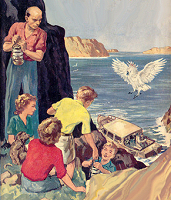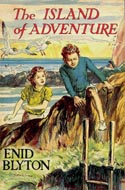

Philip is perplexed by a strange disembodied voice – until he realizes it's coming from a parrot in the tree!

Home at Craggy Tops, Jo-Jo is not amused by Kiki the parrot.
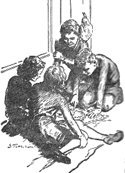
The children find a map of the Isle of Gloom and decide to visit... if they can find a boat!
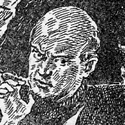
Bill Smugs is surprised when four children show up at his little shack along the beach.
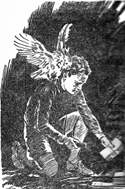
In the tunnels under the island, Jack discovers the real reason the old mines seem to be back in use!
The Island of Adventure
Review by Keith Robinson (March 10, 2005)
The first page of this book has a great hook! Anyone picking this up in a bookstore and reading the first few lines should be drawn in by the strange voice that seems to come from nowhere as Philip is sitting under a tree on a hill puzzling over algebra. Of course, after a while you find out it's just Kiki the parrot, sitting on a branch above, but by then I think a reader would be suitably drawn in. So kudos to Enid Blyton for starting a book – and a series – in a way that "grabs" (as opposed to the usual talk of "boring hols").
I have heard it said that The Island of Adventure starts slowly, and perhaps it does. But I think it's very nicely written, full of colorful detail and interesting characters, and the setting of Craggy-Tops, where Philip and Dinah live, is excellent. I suspect that, as far as this series goes, the first of the eight books is probably only slow when compared to the others – but reading this fresh (and barely remembering a single thing from my childhood) I feel the slow start is necessary to draw the characters and setting before plunging us deep into action. But then again, a young reader probably has a shorter attention span than me, so...
Anyway, as for the actual plot: When Jack and Lucy-Ann come to stay with Philip and Dinah at Craggy-Tops by the sea, Jack has it firmly in mind that he simply must go to the Isle of Gloom, a small island obscured by a haze of mist. There are literally thousands of birds there, and Jack swears he caught sight of a Great Auk, thought to be extinct. Joe, unfortunately, refuses to take the children out in his boat at all, let alone to the island, so Bill Smugs – a friendly man living in a rundown shack a mile and a half along the beach – offers to take them out in his. But not to the island, because it's surrounded by vicious rocks. No, Bill is happy to show them how to put up the sail and control the boat, and let them use the boat on their own while he's not around, as long as they promise not to go to the island.
But Jack has another plan up his sleeve, one that will bypass the promise they made to Bill. They'll wait for Joe to go shopping in town, and borrow his boat! And so they do, finding a way to the island through a narrow pass in the rocks shown on an old map. On the island they find deep, seemingly bottomless shafts, most of which have old, ruined ladders. But one of the shafts has a sturdy ladder, and down the children go... into adventure!
All the way through the book the reader is led to believe that the old copper mines on the island, long closed, are being secretly mined once more. Is Bill Smugs as friendly as he appears, or does he have a dark secret? Is he somehow working with the men on the island? And why is Handyman Joe such a stick-in-the-mud all the time? By the end of the book you realize that there is something much more interesting than copper mining going on, and that Bill Smugs is actually a "member of the police" (presumably an undercover detective, although it's never really mentioned outright in this book) by the name of Bill Cunningham. This may be giving something away to first-time readers of this series, but I think it's fairly obvious anyway... and besides, Bill Smugs is pretty well-known as a good guy to anyone who's ever heard of the Adventure series. Anyway, it turns out that Bill has been after this gang for some time, and that the baddies have been using the island as the perfect secret place for their illicit operation.
The journey under the sea, through a long, long tunnel that connects the mainland to the Isle of Gloom, is very nicely done, and (I think) completely realistic. I had reservations about the thought of a man-made tunnel, but no, Enid Blyton describes a natural underground fissure with a few alterations here and there to make it a little more passable. And the entrance to the tunnel is pretty cool too – down the well! I did wonder, though, why Bill said it would be foolish to go climbing down wells and through underground passages in the dead of night, and that they should wait until morning. Why? Would it be lighter underground during daylight? ;-)
I read somewhere that the publisher of this recent edition changed the color of the rock on the Isle of Gloom from red to green. Being copper-tinted, the rocks would have a greenish hue, not red. But the publisher missed a bit, and one rock stood out with a reddish tinge. So rather than correct something that children might not be aware of anyway, they've only confused the issue by having first green rocks and then red ones. Tsk!
As I said earlier, the handyman, Joe, is a real stick-in-the-mud, always telling stories about "weird things" over on the Isle of Gloom to keep nosey children from prying. He's generally grumpy and mean. According to Nigel Rowe in the UK, "I guess you must be reading a politically correct version... In my c50s reprint, the servant is a sullen, slightly mad black man with rolling eyes, and his name is Jo-Jo. I would imagine your Joe is white, so as not to offend black people!" So the publishers have been at it again, have they? Apparently it's perfectly okay to portray a white person as slightly mad. Hmm. I'm not sure how I feel about that. But it's true – there's no mention of Joe being black in this recent edition, although he has rolling eyes, lined skin, and very white teeth.
Blyton's bad guys are the usual half-brained bunch, with no real air of menace other than their threats of "dealing with interfering kids." Jake has a patch over one eye (a change from the usual scar on the cheek) and Olly... well, I immediately thought of Oliver Hardy: "Well, that's another fine mess you've got us into... " Both Jake and Olly are pretty inept at keeping kids under control, and Joe comes across much more vicious and nasty throughout, and especially at the end. I guess when you're young, reading these books for the first time, the baddies do come across as mean and dangerous... but they really don't seem to pose much of a threat until the end.
And what an ending it is! This is Big Screen action, the sort of scrape Indiana Jones would get caught up in. I won't give it away here, but it's all very nicely done and has a realistic feel to it, even for this adult reader! Overall, very good stuff.
Review by Heather from Australia (March 30, 2005)
The Adventure series kicks off quite remarkably with this book. I think these must have been very well received at the time of writing, with only the first one or two books of the other Mystery/Adventure series in existence (Famous Five was the most advanced, up to book 3 at the time The Island of Adventure was released). With more fairy tales and short stories being published than anything else, Blyton hadn't yet branched out into Mystery/Adventure so much and had focused on a younger audience. The Adventure books would have given the older children something exciting to delve into, and certainly seem to be a fore-runner of some of the Famous Five's later escapades.
The first section of the story, which is set at a teacher's home, is there mostly to describe the characters and get them all together. Phillip and Jack immediately become fast friends and hatch an ambitious plan to allow Jack and Lucy-Ann to go to Phillip's home at Craggy-Tops. There they join up with Phillip's sister Dinah and begin their adventure.
I love the descriptions of the scenery throughout the book. Blyton's imagination has really run away with her, and reading the book you begin to feel as if you are really there, looking over the misty ocean towards the Isle of Gloom through a slit shaped window at the top of a tower. Then you creep through a musty tunnel to discover secret rooms with Phillip and Jack before navigating choppy seas towards the island. The vivid descriptions and realistic but magical setting really sets this book apart.
The undersea tunnel must also be mentioned – it is impeccably described, and again you feel as if you are there with Phillip and Bill Smugs. The entrance hidden down a well is ingenious. Blyton was obviously delighted by the idea herself, as she used a very similar undersea tunnel to connect two islands in The Adventurous Four Again three years later and several years after that adapted it in The Ring-O-Bells Mystery to a long, secret underground tunnel that runs between Ring-O-Bells Hall and an entrance half way down a well.
Bill Smugs is an almost shady-sounding but likeable character – you spend much of the book trying to decide whether he is good or bad – and is one of the few characters that Blyton writes in this half-and-half manner. Most of her bad guys are obvious at first mention, and the good guys also stand out. Bill obviously turns out to be a good guy, and his strange behaviour is explained, but he does keep you guessing.
My favourite character in The Island of Adventure is actually one of the bad guys. Jo-Jo, the black servant (changed to Joe the white servant in newer editions), is a wonderfully colourful person, with wild eyes and a dark side that makes you sure from the beginning that he must be part of the adventure. He keeps telling the children not to look at the Isle of Gloom because only bad things happen there, and not to venture out at night for fear of the "things" that roam around. The children are of course far too intelligent to take any notice of these warnings, and quickly label him as odd, mad and not to be taken notice of. Their underestimation of him could have put them all in hot water, but fortunately they kept him out of things just because they found him annoying and didn't want him meddling. Jo-Jo is continually confounded by the children disappearing into thin air and evading his efforts to keep an eye on them. He shows his evil side out in the darkness when Jack runs into him one night while trying to find out about the mysterious lights coming from the island. This is when the reader realises he isn't just a madman – there is something more sinister about him.
The recent "sanitising" that has taken place in the book to erase Jo-Jo's black skin annoys me a little – I don't see any real reason for it. The other bad guys are all white, and are shown in the illustrations as such. At the time the book was written it makes perfect sense that the servant in such a wild, isolated place could quite logically be black – many servants were.
I am glad Phillip and Dinah's aunt and uncle are phased out of the series in the later books. I found them a little unremarkable (much like George's parents in the Five books) and got in the way of the story rather than enhancing it. They did provide a few convenient impediments, such as keeping Jo-Jo busy while the children ran off, and providing maps of the underground mines and secret passages. However other than that they didn't really add much to the story. Possibly Blyton made them that way on purpose, and didn't develop their characters because she knew that was going to be their only appearance in the series.
The rest of the bad guys down in the mines are not quite as scary (or interesting!) as Jo-Jo. They are obviously not overly intelligent, and remind me a little of Mr Goon in the Find-Outers series. The children outsmart them several times, and even Kiki gets in on the action, although I don't know how Kiki imitating Aunt Polly's voice (an older woman) could possibly make anyone think that Jack (a young boy) was locked up in the room! Surely you would at least check to see!
The end of the adventure is nail-biting stuff. The two boys along with Bill Smugs are in danger of being shot and later drowned alive, and then must find a very risky method of escape. All this ensures nobody could dream of putting the book down during the final two chapters. A very good beginning to arguably Blyton's best Adventure/Mystery series of all.
Review by Harikrishnan Menon (added December 12, 2005)
Note: The following synopsis contains spoilers. If you haven't read the book, you may not want to read this. I've put comments on language changes and other oddities as I went along, because I thought it would make more sense if these are seen in context.
The very first book in the Adventure series, The Island of Adventure starts off with Philip Mannering being mystified by a rude voice that addresses him when he's lying under a tree doing algebra problems. The disembodied voice belonged to Kiki the parrot, owned by Jack Trent. The chapter describes Philip's first meeting with Jack and his sister Lucy-Ann.
Philip was staying at the home of Mr Roy, a teacher, and Jack was having lessons there too. Not being overly popular with Mr Roy, thanks to Kiki's rude comments, Jack decides to run away. With Lucy Ann, he plans to go with Philip to the latter's home, Craggy Tops. Philip lived there with his sister Dinah, with an aunt and an irascible and absent-minded uncle (shades of Uncle Quentin?) for company.
The three kids alight at a 'lonely little station' and find an unlikely couple waiting for them. One was Dinah, Philip's sister, and the other was the family handyman Jo-Jo (or Joe, depending on the edition you have): "Jack and Lucy-Ann saw a coloured man coming towards them. His skin was black, his teeth were very white, and he rolled his eyes in a peculiar way." [1944]
Compare this with the politically correct version: "Jack and Lucy-Ann saw a strange man coming towards them. His skin was lined, his teeth were very white, and his eyes darted from side to side as he looked at them." [1988]
Observe how Jo-Jo has been given a makeover. He's even stopped rolling his eyes and become simply shifty-eyed. The older, non-PC version is more realistic, in my opinion. Subsequent references to rolling eyes have been eliminated, except for one stray instance (probably an oversight – no pun intended).
Here's what Philip says in 1944: "Jo-Jo, put that trunk in the car too. It belongs to my two friends."
And in 1988: "Jo-Jo, that trunk should go in the car too. It belongs to my two friends."
Rather subtle. The change was probably made because the former sounds more peremptory, almost as if Philip was addressing a servant/slave?
They all pile into a rattletrap of a car driven by Jo-Jo (I'll call him that for the sake of consistency) and finally reach Craggy-Tops. What's it like? Yes, you guessed it – it was a "queer place".
Aunt Polly is at first dismayed at seeing the two extra visitors, but is slowly convinced by Kiki and Mr Roy. I'm not going into the details; it's all there in the book. :)
The days go by. Some trivia: Jo-Jo's "queer beliefs" become "strange beliefs" in the 1988 edition. And the word "to-morrow" loses its hyphen.
At Craggy-Tops, water has to be "pumped up from a deep, deep, well". Later in the story, the children are presented with a bucket and rope.
Philip and Jack get to sleep in a tower room, with a view of a mist-shrouded island some distance away in the sea. It was "a queer place to sleep for the first time at Craggy-Tops." In the middle of the night, Jack felt cold, so he "cuddled up against Philip's back" and went to sleep. Ah, so that's what happens in queer sleeping quarters.
The children run into a mysterious "birdwatcher" who calls himself Bill Smugs, and whose boat comes in handy, especially since Jack is convinced he'd see a supposedly extinct Great Auk. The plot falters a bit at this stage as the children take out Jo-Jo's boat by themselves one day and come upon some mine shafts (part of a long-abandoned copper mine) on the mysterious island.
The children had run up against a wad of counterfeiters but are remarkably naive about it. For quite some time they believe the thugs are Bill's pals working the old copper mines.
Everything turns out all right in the end, and Jo-Jo gets his just desserts for all his black deeds.
While not as thrilling as Castle or Valley, Island does have its redeeming features. We see how the children get to know each other, learn about their less-than-privileged backgrounds, and the first meeting with Bill. The flare-ups that Philip and Dinah have are made obvious. So is the budding sexual chemistry between Jack and Philip. (Hey, I'm only kidding!)
In short, The Island of Adventure serves to whet your appetite for a nice juicy main course – which comes in the form of Castle and Valley.
But that's another review...


